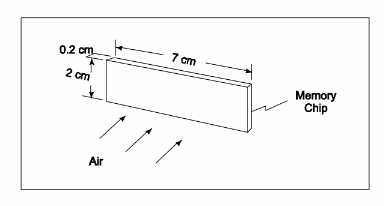A uniform linear charge of 3.0 nC/m is distributed along the y axis from y = ?3 m to y = 2m. Which of the following integrals is correct for the magnitude of the electric field at y = 4 m on the y axis?
A.

B.

C.

D.

E.
Answer: A
You might also like to view...
To decrease the size of personal computer mother boards, designers have turned to a more compact method of mounting memory chips on the board. The single in-line memory modules, as they are called, essentially mount the chips on their edges so that their thin dimension is horizontal, as shown in the sketch below. For safe operation (so that the VLSI microchips do not “burn out”), their maximum temperature always has to be <=75°C under all operating conditions. Assuming that the memory board, housing the chip modules, is also at the same temperature, determine the maximum power that is dissipated from the chips if the board is cooled by air at 20°C. The air flows perpendicular to the board face, as shown in the figure, with a velocity of 10 m/s. Consider the heat loss from both the
front face and back face of the memory-modules board. Is it beneficial (dissipate more heat) if the board was aligned parallel to the air flow? To model the board, in both cases, consider an equivalent “square” of the same rectangular face area and determine the appropriate length scale.
GIVEN
• Computer memory chip in an air stream as shown above
• Chip temperature (Ts) = 90°C
• Air temperature (T?) = 20°C
• Air velocity (U?) = 10 m/s FIND
• The maximum power dissipation ( Q G)
ASSUMPTIONS
• Radiative heat transfer is negligible
• Use for a non-square surface will not introduce significant error
• Heat transfer from all four edges of the chip is negligible

Short duration gamma-ray bursts are explained as the merger of two neutron stars
Indicate whether the statement is true or false
Monochromatic light from a He-Ne laser (l = 632.8 nm) is incident on a diffraction grating containing 5 000 lines/cm. Determine the angle of the first-order maximum
a. 18.4° b. 39.2° c. 14.6° d. 27.7° e. 13.9°
Order the materials from smallest refractive index to largest refractive index.
=Air =Diamond =Glass =Quartz =Water